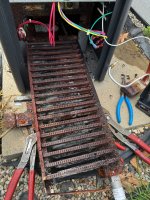Hey TFP,
You may remember me, the one who posted about his Raypak 156A Heater Failure after only 3 years in service, here is the thread:
Raypak 156A Heater Corrosion - Only 3 years old
Well, I replaced it with a new unit, and here I am again, with the exact same problem, this time after only 2 years in service.
I followed Raypak's guidelines to the tee this time and lowered my FC. I ran FC high last time but higher CYA to compensate so should have been no different. I never have CC and never need to SLAM or do algae treatments, water always runs clear. Cup of acid a week to keep the PH down with my SWG. A monthly dose of oxidizing shock and a monthly dose of lanthanide (phosphorous remover) to keep the water crystal clear, none of which modify the chemistry or impact heaters that I can see.
I'm at a complete loss about a unit that has been in service for 10 months across two seasons. I did notice the check valve trickling back some water when the pump was off. Could that be causing this destruction? (See other thread for setup.) I use a 1/2 HP variable speed now vs the 1HP Hayward.
FC 3
CC 0
pH 7.6
TA 80
CH 200
CYA 60
NA 3200
You may remember me, the one who posted about his Raypak 156A Heater Failure after only 3 years in service, here is the thread:
Raypak 156A Heater Corrosion - Only 3 years old
Well, I replaced it with a new unit, and here I am again, with the exact same problem, this time after only 2 years in service.
I followed Raypak's guidelines to the tee this time and lowered my FC. I ran FC high last time but higher CYA to compensate so should have been no different. I never have CC and never need to SLAM or do algae treatments, water always runs clear. Cup of acid a week to keep the PH down with my SWG. A monthly dose of oxidizing shock and a monthly dose of lanthanide (phosphorous remover) to keep the water crystal clear, none of which modify the chemistry or impact heaters that I can see.
I'm at a complete loss about a unit that has been in service for 10 months across two seasons. I did notice the check valve trickling back some water when the pump was off. Could that be causing this destruction? (See other thread for setup.) I use a 1/2 HP variable speed now vs the 1HP Hayward.
FC 3
CC 0
pH 7.6
TA 80
CH 200
CYA 60
NA 3200


